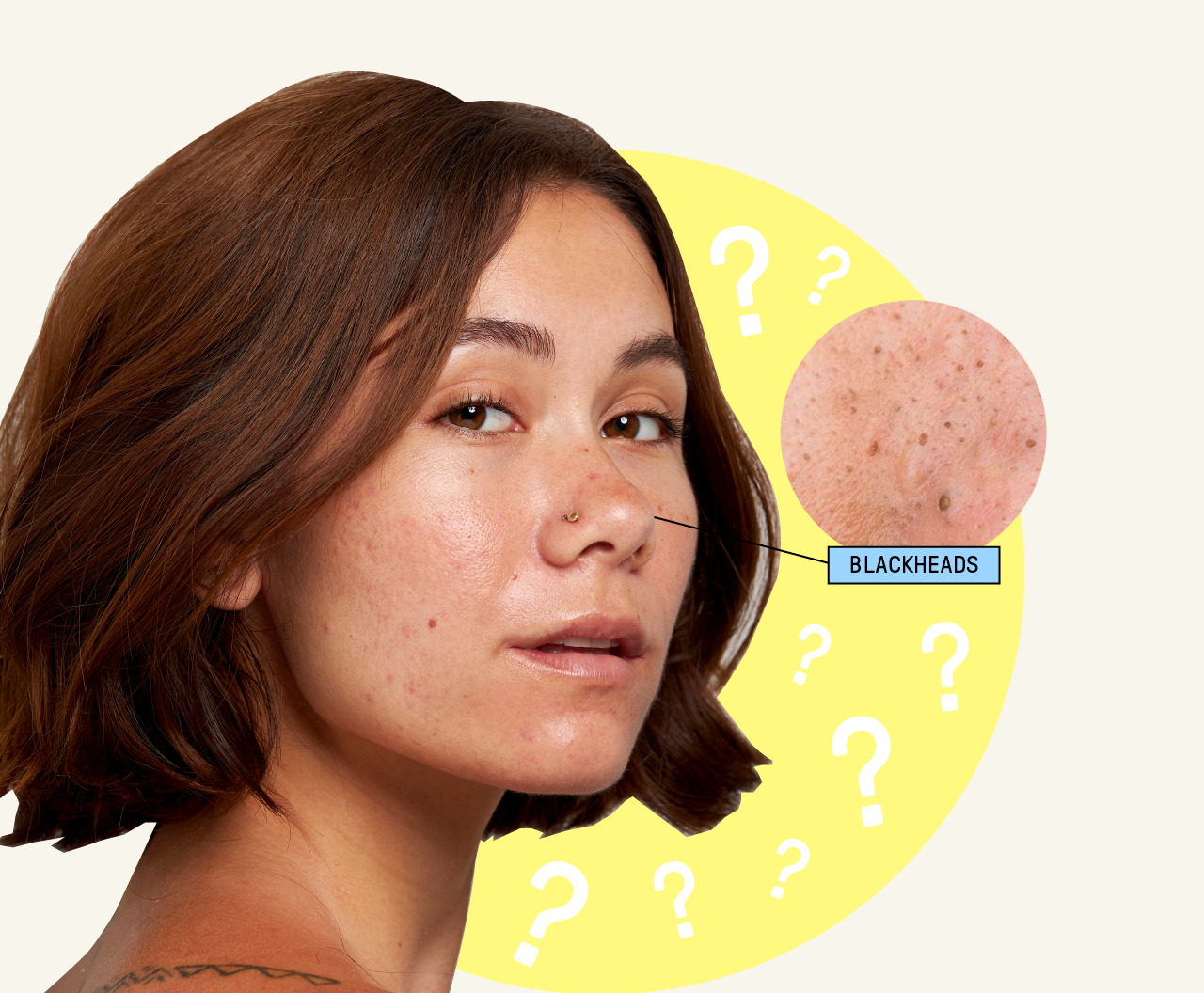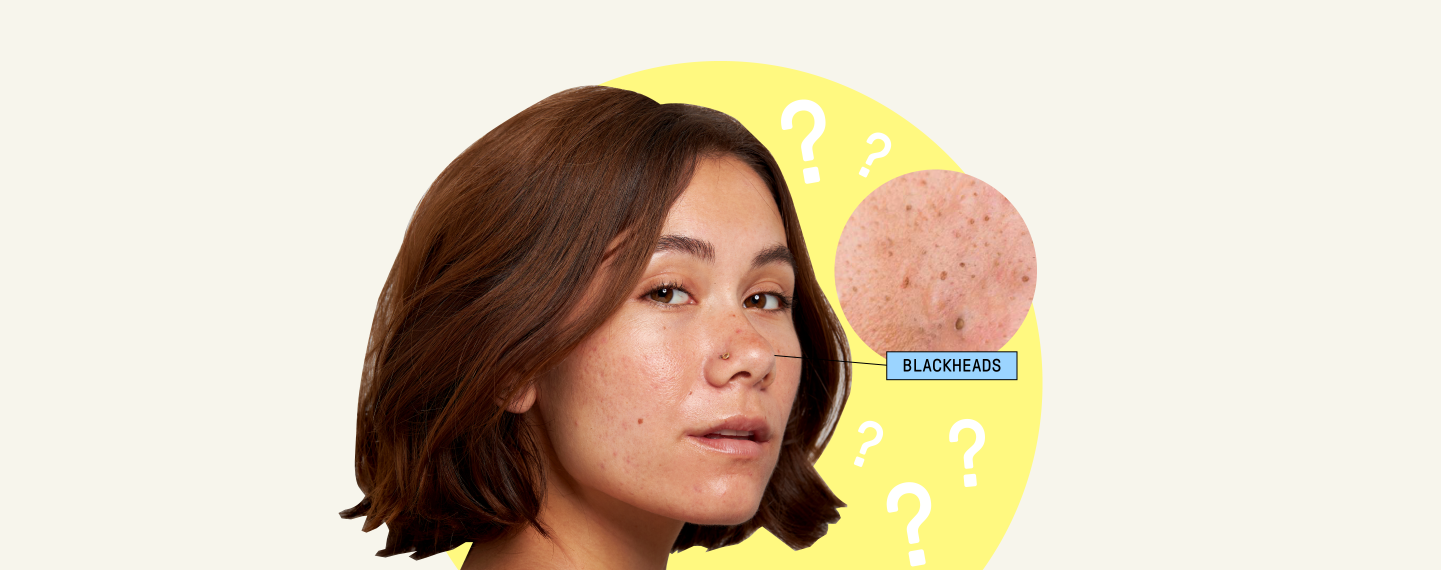Education
Best treatment for blackheads


SHARE
Education
Best treatment for blackheads
Medically reviewed by Angela Sheddan, DNP, FNP-BC
Written by Apostrophe Team
Last updated 11/3/2024
Most doctors will probably agree that, as types of acne go, blackheads are not the worst you can be afflicted with.
Between the cystic and fungal infections that can signal severe breakouts, most doctors would tell you that blackheads are a more mild form of acne.
Why do we hate them so much then?
For starters, they’re visible—and they give true meaning to the concept of clogged pores.
They’re partly why facials are so popular. It’s relaxing to have someone pamper you and massage your face, but getting rid of blackheads via professional extractions can make you feel like you’re well on your way to healthier skin. At least, you might feel better about your pore size.
(Hello, Instant Gratification.)
Treating blackheads, luckily, isn’t very complicated either—it just may require some extra steps in your skincare routine, or possibly some assistance from a healthcare professional.
First: the basics on blackheads and how to treat them.
What are Blackheads?
To put it simply, acne is what happens when your pores function poorly and get clogged with different types of gunk.
That gunk can be dead skin cells, excess oil, thriving bacteria colonies or things like pus.
Acne occurs when dead skin cells get stuck in a pore rather than leaving as directed. When dry, dead cells accumulate, your pore produces extra sebum (oil) to boot them out.
Sadly oil is a breeding ground for acne bacteria—creating the potential for inflamed, painful breakouts.
Why Blackheads are Different
Skin blemishes and acne can vary in severity as well as how bad they look. Blackheads represent the most visible of the milder forms of acne.
Blackheads and whiteheads are bumps filled with oil and dead skin. Whiteheads are closed versions, and blackheads are open.
In other words, a pesky blackhead is a combination of gunk clogging your pore, and totally visible to the naked eye.
It can get much much worse: Whiteheads can become inflamed and create papules, or can become inflamed and create pus, leading to pustules.
That “black” coloring that you see in your clogged pores is because the melanin in the dead cells reacts with exposure to air, which causes it to oxidize and look much darker.
Closed pimples (whiteheads) simply haven’t had the oxygen exposure to change colors.
Best Blackhead Treatments
Okay, so you know what they are and why they look the way they do… So what is the best treatment for blackheads? How do you get rid of them?
Good question—and there are a variety of answers. Here is a list of different treatments you may want to consider.
Use Antibacterials and Antimicrobials
Sometimes attacking bacterial and fungal problems at their source is the best option.
Antibiotics are an effective treatment for more severe acne outbreaks.
In addition to the ones you’ve heard of, consider looking into clindamycin, which is a powerful antibiotic used to treat organ infections—and in its topical form, acne.
Remove Excess Oil
Witch hazel, blotting papers, and a good clay mask can all be effective in removing excess oil when used carefully and can help reduce the amount of blackheads you’re going to have.
While those over-the-counter options may work for some people, benzoyl peroxide or salicylic acid are stronger options that can really kick excess oil to the curb.
Be careful to not strip your skin, though. Oil can serve as a protective barrier, and help keep dirt off your skin.
Removing too much oil from your skin can also lead to excessive dryness which in turn can cause irritation and breakouts.
Moisturize Your Skin
Hydration is a key element of good skin care, and it’s also incredibly important for preventing blackheads.
Dead, dry skin cells can stick together and cause comedones (blackheads) to fill your pores. A moisturizer can help keep skin cells from being too dry when they slough off.
A non-comedogenic (non-clogging) moisturizer can actually help keep your pores clear.
Look for a moisturizer with hyaluronic acid, which has been shown to help skin retain an incredible amount of moisture—many times its own weight.
Exfoliate Gently
Exfoliating is a great way to remove dry skin to help keep your skin clear.
Chemical exfoliants like retinoids can help slough skin gently and gradually.
Retinoids are vitamin A compounds that do the double duty of both getting rid of dead cells and boosting your skin’s collagen synthesis.
Prescription retinoids like tretinoin might be a great option if more mild over-the-counter versions haven’t helped.
Tretinoin has been around for decades, and it has also been shown to increase collagen synthesis.
Make Healthful Lifestyle Changes
There are a lot of things you may be doing wrong right now that don’t even involve your skin.
Allowing your body to suffer from a high glycemic diet, poor hydration, or general stress can lead to acne—not to mention diabetes, hypertension and plenty of other conditions you wouldn’t want and can avoid. (Note: These lifestyle behaviors can also cause wrinkles.)
Studies suggest some correlations between diet and oil production, but it’s commonly known that a healthful diet and good hydration can help lead to healthy skin.
Beating Blackheads for Clear Skin
Whether you try one or a dozen different washes, creams or serums in your search for the best acne treatment for blackheads, one thing is certain: the fastest way to a solution is to talk to a healthcare professional.
Whether you have severe acne or persistent yet mild issues, a healthcare professional can help you pinpoint what’s causing your blackheads, along with the best ways to treat them.
For more on how to manage blackheads, check out this guide on how to get rid of blackheads.
8 Sources
Rodan, K., Fields, K., Majewski, G., & Falla, T. (2016). Skincare Bootcamp: The Evolving Role of Skincare. Plastic and reconstructive surgery. Global open, 4(12 Suppl Anatomy and Safety in Cosmetic Medicine: Cosmetic Bootcamp), e1152. https://www.ncbi.nlm.nih.gov/pmc/articles/PMC5172479/
Kraft, J., & Freiman, A. (2011). Management of acne. CMAJ : Canadian Medical Association journal = journal de l-Association medicale canadienne, 183(7), E430–E435. https://www.ncbi.nlm.nih.gov/pmc/articles/PMC3080563/
Yoham AL, Casadesus D. Tretinoin. updated 2020 dec 5. In: StatPearls internet. Treasure Island (FL): StatPearls Publishing; 2021 Jan-. Available from: https://www.ncbi.nlm.nih.gov/books/NBK557478/
Acne: Treatment, types, causes & prevention. (n.d.). Retrieved February 20, 2021, from https://my.clevelandclinic.org/health/diseases/12233-acne
American Academy of Dermatology Association. (n.d.). CAN THE RIGHT DIET GET RID OF ACNE? Retrieved March 5, 2021, from https://www.aad.org/public/diseases/acne/causes/diet
InformedHealth.org internet. Cologne, Germany: Institute for Quality and Efficiency in Health Care (IQWiG); 2006-. Acne: Overview. 2013 Jan 16 updated 2019 sep 26. https://www.ncbi.nlm.nih.gov/books/NBK279211/
Hoover E, Aslam S, Krishnamurthy K. Physiology, Sebaceous Glands. updated 2020 oct 26. In: StatPearls internet. Treasure Island (FL): StatPearls Publishing; 2021 Jan-. Available from: https://www.ncbi.nlm.nih.gov/books/NBK499819/
Jegasothy, S. M., Zabolotniaia, V., & Bielfeldt, S. (2014). Efficacy of a New Topical Nano-hyaluronic Acid in Humans. The Journal of clinical and aesthetic dermatology, 7(3), 27–29. Retrieved from https://www.ncbi.nlm.nih.gov/pmc/articles/PMC3970829/
Shop this post

Clindamycin
Like what you just read? Sign up for our email list to get the scoop on skincare science delivered straight to your inbox.

Deep Dives
A dermatologist shares his thoughts on the recent studies about benzoyl peroxide and benzene.
Read More
Education
What is milia?
What is milia? Today, we’re jumping into one type of bump that you may have heard about most commonly in infants — milia.
Read More
Education
Best moisturizer for acne-prone skin
If you have combination acne-prone skin, figuring out which moisturizer is best for your skin might be tough. In this guide, we break down the best moisturizer for combination, acne-prone skin.
Read More
